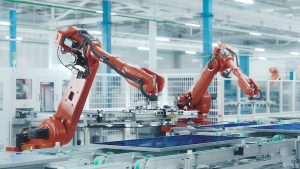In the modern and competitive world of today, an essential point to pay attention to is the dynamism and adaptability of machines as per the fluctuations in end-user requirements. In the case of OEMs, success depends on the capacity to build enhanced machines in terms of production speed and output standards. Adjustable architectures are essential in order to comply with diverse end-user specifications, as well as supporting proper infrastructure for the Industrial Internet of Things (IIoT). It is important to remember the fact that machines must be safe and secure to use for the operator. The inception of Variable Speed Drives (VSD) has helped address these challenges. A VSD is an automated device that oversees and regulates the speed and rotational force – commonly known as torque output – of an electric motor. These drives are augmenting the management of mechanical movement-oriented processes such as packaging, material handling, material working, and hoisting. Control these mechanical movements depends heavily on the functions drive technologies which can start and stop motors rapidly with sufficient fluxing capabilities and motor current, and with the skill to replicate tasks during a given process. Accurate control of mechanical movements in these areas of application result in the given benefits:
- Efficiency: Today, synchronous motors are much more prevalent in industrial applications as compared to induction motors, due to their energy-saving characteristics and dynamism. VSDs can regulate IE2, IE3 & IE4 induction motors, reluctance motors, and synchronous motors. In relation to the application, up to 30% of energy can be saved using VSDs. In the case of direct online start situations, the motor runs at a nominal frequency with no possibility of controlling the motor speed. Additionally, the equipment lifetime is significantly reduced due to the mechanical stress caused by direct start/stop methods. On the other side of the spectrum, VSD-based applications offer thermal motor protection, an optimal amount of torque, and the mitigation of mechanical stress on the system, all while lowering energy consumption.
- Safety: In applications like material working or woodworking, emergency stop functions help evade accidents and increases productivity. Emergency stop functions refer to the mechanism of bringing a machine to a protected operating state within the shortest timeframe possible. Material handling and conveying functions can also be ensured, depending on the design needs. For example, safety sensing devices such as light curtains or door locks can be used to limit machine speed, or to stop the machine if necessary. Drives are adorned with a Safe Torque-Off (STO) dual safety input. They comply with machine safety standards (including EN ISO 13849-1 and EN62061), meet machinery directives, and have the ability to address specialised safety needs. These drives offer sharp and easy-to-integrate functional safety.
- Predictive maintenance: Some VSDs come with a web server that can perform the duty of controlling the continuity of an application with a time-stamped motor, or drive important data. In addition to this, the motor or drive data can be shared with a centralised platform – namely, a programmable logic controller (PLC) – in the case of an application fault. The VSD offers motor and drive information such as motor current, motor thermal state, motor torque, drive thermal state, and DC bus voltage at the accurate time of default (over a 50ms duration and within 5ms intervals). Repetition of the fault can be avoided by ringing alarms and warnings or by even halting the application. This allows issues to be efficiently dealt with before any mishaps eventually occur.
- Connectivity and cybersecurity solutions: VSDs are connected devices that can be used to log application data with a time-stamp without the need of installing sensors physically. As more industrial machines and control systems connect to the internet, cybersecurity presents itself as a growing concern. VSDs, with their functions, help negate the threats caused by cybersecurity.
VSDs that support web services bring IIoT connectivity at the device level and also offers functions to analyse and enhance their functions. This enables them to implement solutions while testing and subsequently unexpected downtime in the future.
This blog is inspired by Baris Aytekin . Click here to read more.


